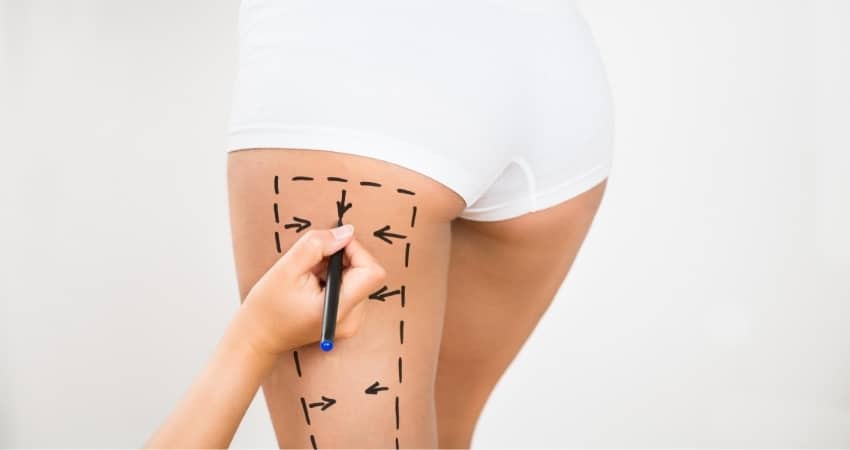Dr. Hootan Daneshmand
Thigh Lift
Thigh Lift Surgery in Orange County & Bakersfield, CA

You may be seeking for a solution to produce smoother, more shapely legs if you’ve recently dropped weight in your thighs. Maybe you’re seeking a solution to tighten the skin on your thighs, which tends to sag as you get older. This is a common concern for women especially, as they are more likely to carry weight in their hips and buttocks.
At the Silhouette Plastic Surgery Institute, we specialize in giving you your dream figure by perfecting your silhouette, whatever that may look like for you. It’s in our name, after all! Let’s discuss some of the ways we can do that through thigh lift surgery.
What is a Thigh Lift?
You may be seeking for a solution to produce smoother, more shapely legs if you’ve recently dropped weight in your thighs. Maybe you’re seeking a solution to tighten the skin on your thighs, which tends to sag as you get older.
A thighplasty, also known as a thigh lift, is a cosmetic surgical operation that tightens excess skin on your thighs caused by aging, pregnancy, or major weight reduction and improves their appearance. Drooping skin and a flabby appearance may cause your thighs to appear dimpled. Thigh lift surgery addresses these issues by elevating and contouring your thighs so that they appear slender and in proportion to the rest of your body. To give thighs a smoother, more toned appearance, a combination of thighplasty and liposuction methods may be used.
Pregnancies and major weight loss can result in sagging skin on the thighs and hips. Unfortunately, this can lead to the extra skin draping the lower torso. The outer thighs expand into “saddlebags,” while the buttocks sag with skin folds that resemble accordions. People seeking thigh lift surgery keep in mind that it is not a weight-loss surgery. It’s a procedure for those who are near to their target weight, but don’t like how their thighs look. At Silhouette Plastic Surgery Institute, Dr. Daneshmand specializes in surgery procedures of the face, breast, and body, and has performed countless thigh lift surgeries.
Also Known As: Thighplasty
Thigh lift surgery is major surgery. The procedure typically requires general anesthesia, which means you will be asleep during the procedure. Be sure to have a partner or close friend accompany you on surgery day, as you will be unable to drive yourself home afterward.
You must prepare ahead of time for your recovery. Fill any antibiotic or pain management prescriptions ahead of time. It may be best if children or pets stay with a friend or loved one for the first few days following your surgery. Easy-to-prepare meals should be purchased or readied prior to surgery day. It will be tough to move around after your thigh lift, so have a “healing buddy” stay with you or keep track of your progress.
There are several types of thighplasty that include inner, medial, bilateral, and mini thigh lifts. Inner and medial thigh lifts are typically performed as outpatient surgery. It’s possible that a bilateral thigh lift will require an overnight stay in the hospital.
Ideal Candidates for a Thigh Lift
Before considering a thigh lift, candidates should be at or near their goal weight before seeking to contour their bodies. Thighplasty candidates have often lost significant amounts of weight or show other signs of some similar strain, like pregnancy and motherhood. Ideal candidates for thigh lift surgery are people who have a generally constant weight, have additional soft tissue in the inner (medial) and/or outer (lateral) thigh regions, and who are in good health and do not have any medical issues that would make surgery more difficult or risky.
Doctors recommend that if you’re considering this operation after losing weight, you’ve been at a stable weight for at least 6 months and have already reached your goal weight. This is due to the fact that weight changes can affect the outcome of thigh lift surgery.
Inner Thigh Lift Surgery
An inner thigh lift targets the skin in the lower section of your inner thigh. It includes an incision at your inseam area, along the inner thigh. Sometimes the incision will extend around the back of the thigh. This enables your surgeon to access the underlying tissues while creating the smallest incision possible, so the resulting scar can be easily hidden by undergarments. A wedge of skin, and potentially fat, will be removed from the area. The remaining skin will be tightened to improve leg shapes.
This technique aids patients who are having difficulty losing weight in this area of the body through diet and exercise. Reduced skin elasticity caused by the aging process or significant weight reduction can also be addressed with an inner thigh lift.
How Does Thigh Lift Surgery Work?
Thigh lift surgery is commonly performed as an outpatient treatment under general or epidural anesthesia. The incision pattern varies depending on the type of thigh lift and the area being treated. An incision in the groin area is used to commence the most frequent thigh lift method. Skin and/or fat are removed in all cases, the underlying tissue is molded and tightened, and the remaining skin is elevated and smoothed before being sutured in place at the incision site. Surgical procedures usually take 2 to 3 hours.
There are risks associated with any type of surgery. The risks with a thighplasty include the following:
- Anesthesia risks
- Poor healing of the wound
- Bleeding
- Infection
- Asymmetry
- Deep vein thrombosis
- Pain
- Pulmonary or cardiac complications
- Fat necrosis
- Skin loss or discoloration
- Numbness
- Loose skin
- Unattractive scarring
It’s possible that you’ll need revision surgery to fix these issues.
What is the Recovery Time for a Thigh Lift?
It is essential for a patient to have someone assist them in getting home following surgery and, if possible, to help them around the house for a few days afterward. Simple tasks like going to the restroom and preparing food can benefit from the assistance of your “recovery buddy.” Most doctors recommend that you take seven to ten days off work to recover.
To aid the healing process, patients must remain in either an upright or reclined position with their legs slightly bent during this time. Pillows under the knees are frequently used to improve comfort. It’s crucial to avoid stretching the legs all the way out when it comes to a proper resting position. This avoids putting further strain on the thighs and sutures that are in place.
There will be bruising, swelling, and pain in the area following surgery. Compression garments will be needed to reduce swelling and improve healing. Drains may be installed to collect excess fluid and reduce infection risk.
Within two weeks, the surgical sutures will be removed. During the post-operative phase, pain relievers and anti-inflammatory drugs are commonly provided. You won’t be allowed to bathe, swim, or soak in a hot tub until your surgeon gives you permission. Showering is permitted 48 hours following the surgery. Within 7 to 10 days, you should be able to return to work, and within 4 to 6 weeks, you should be able to resume strenuous exercise. While scars do exist, they are generally hidden in your body’s natural wrinkles and dissolve with time.
The effects of a thigh lift are immediately noticeable. However, the ultimate outcomes may take many months to fully develop.
Looking to Remove Inner Thigh Fat? Contact Silhouette Plastic Surgery Today!
Because of the complexity of cosmetic surgery, it’s critical to find an experienced surgeon who has performed thigh lifts before. Before you commit to the surgery, your surgeon can go over any potential side effects and risks with you.
Overall, you should expect to be out of commission for several weeks. However, if you get a thigh lift performed by the right surgeon, you may find that the treatment is well worth your time and money. We invite you to consult with Dr. D at the Silhouette Plastic Surgery Institute today to see how we can transform your thighs with a Bakersfield thigh lift surgery. Call (949) 359-8397 for a consultation.
